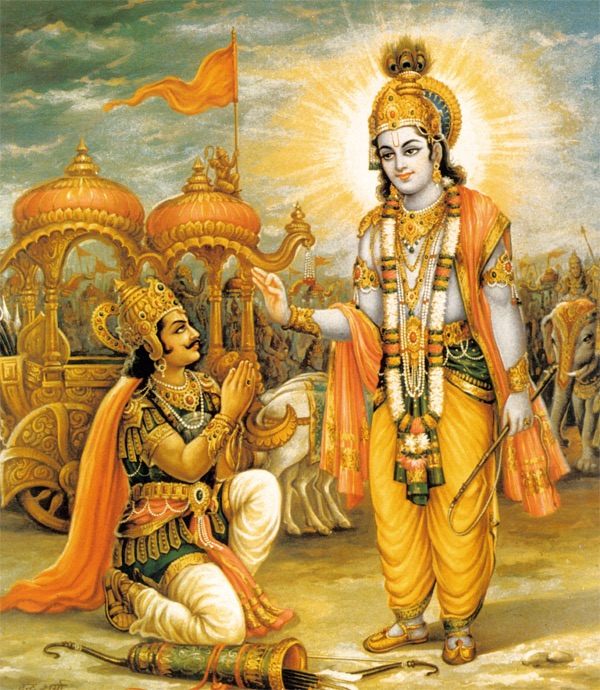History, from a purely material perspective, can seem like a never-ending cycle of rise and fall, of conflict and resolution. But the Bhagavad Gita, a timeless spiritual text, offers a different lens through which to view the unfolding of events – as His-story, the divine play of Krishna, the ultimate reality. This perspective doesn’t deny the challenges and suffering of the world, but it invites us to see a deeper meaning and purpose behind it all.
Krishna advises Arjuna during the battle of Kurukshetra
The Gita’s Cosmic Perspective: Krishna as the Ultimate Historical Agent
In Chapter 11 of the Bhagavad Gita, Krishna reveals his universal form, encompassing all of creation and time itself. He declares himself the beginning, the middle, and the end, the source of everything that exists. This cosmic vision reminds us that all events, no matter how chaotic or destructive, are ultimately part of a larger divine plan.
This understanding can be both comforting and empowering. It allows us to see beyond the surface-level turmoil and recognize the hand of the divine at work, orchestrating events for the ultimate good of all beings. It also calls us to align ourselves with this divine will, to act in accordance with dharma (righteousness) and contribute to the unfolding of a more harmonious world.
Dharma in Turbulent Times: The Yogi’s Role
In times of upheaval and uncertainty, the teachings of the Gita become even more relevant. The world today faces unprecedented challenges – from political polarization to climate change to social injustice. As yogis, what is our role in the midst of this chaos?
The Gita offers no easy answers, but it does provide guidance and inspiration. It reminds us that our true nature is divine, that we are not separate from the universal consciousness but an integral part of it. It calls us to cultivate inner peace and equanimity, even in the face of adversity. And it urges us to act with compassion, courage, and wisdom, always striving to uphold dharma.
Discerning Truth Amidst the Noise: The Challenge of Interpretation
The Gita, like any sacred text, is open to interpretation. Different individuals and groups may derive different meanings and apply its teachings in diverse ways. This is why it’s crucial to approach the Gita with discernment, humility, and an open mind.
It’s also important to remember that the Gita is not a manual for war or violence. While it does depict a battlefield, the deeper message is about the inner struggle between our higher and lower natures. The true war is within ourselves, and the victory lies in conquering our own ego, attachments, and negative tendencies.
Navigating Uncertainty: Finding Our Own Dharma
In these turbulent times, it’s easy to feel overwhelmed and unsure of how to act. But the Gita reminds us that we each have a unique role to play in the unfolding of His-story. By turning inward, cultivating self-awareness, and seeking guidance from our inner wisdom, we can discover our own dharma and contribute to the healing of the world.
This may involve taking a stand against injustice, offering compassion to those who are suffering, or simply cultivating inner peace and radiating love and light into the world. Whatever form our dharma takes, it’s essential that we act with integrity, compassion, and a deep understanding of the interconnectedness of all life.
Embracing the Divine Play: A Path to Peace and Purpose
The Gita’s message is ultimately one of hope and empowerment. It reminds us that we are not victims of circumstance but co-creators of our reality. By aligning ourselves with the divine will, we can find meaning and purpose even in the midst of chaos.
As we navigate the challenges of our times, let us remember the timeless wisdom of the Bhagavad Gita. Let us embrace the divine play of life, cultivate inner peace, and act with courage and compassion. By doing so, we can contribute to the unfolding of a more just, harmonious, and enlightened world.

